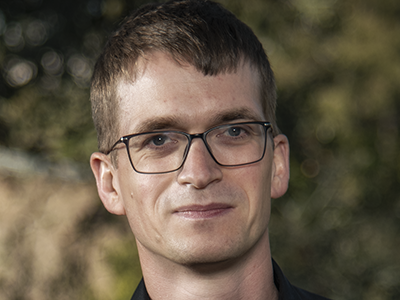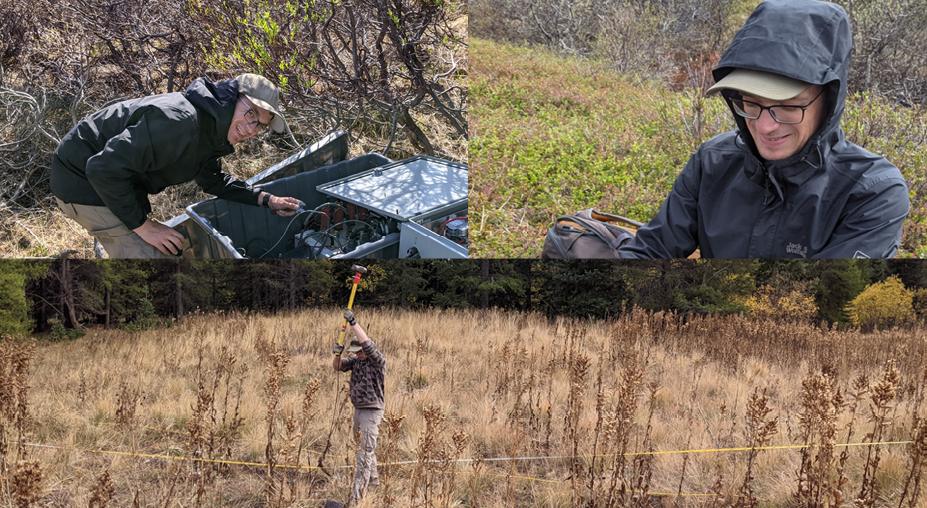Near-Surface Geophysics Section Honoree

Citation
Sebastian Uhlemann is an outstanding early-career scientist who has established himself as an authority on geophysical monitoring of natural environmental processes.
The focus of Sebastian’s Ph.D. at ETH Zurich and the British Geological Survey was geoelectrical monitoring of moisture-driven processes in natural and engineered slopes. He explored, for the first time, true 4D imaging of moisture dynamics in unstable hillslopes. His Ph.D. led to the publication of numerous papers, the collection of which offers new insight into using near-surface geophysical methods to quantify hydrological and geomechanical states within a hillslope, and thus, ultimately, offering some means of forewarning slope failure. Not satisfied with this alone as a challenge, during his Ph.D., Sebastian also took the lead on several other areas of near-surface geophysics research, including the characterization of riparian wetlands using time-lapse methods and aquifer vulnerability mapping in Cambodia, the latter providing crucial information to allow the interpretation of geochemical data related to the widespread arsenic contamination problem in the region.
His move to Lawrence Berkeley National Laboratory as a postdoctoral researcher allowed him to expand his portfolio in using geophysics, examining, for example, permafrost degradation, groundwater recharge, and plant-soil-water interaction. His 2021 transitional permafrost paper reveals how near-surface geophysics can be used to illuminate, not just support. Some of his very recent work explored the integration of near-surface geophysics and other data sources to reveal, at the watershed scale, how topographic features and subsurface properties are interrelated. I am sure that this work will have a long-lasting and significant impact on critical zone science.
Despite completing his Ph.D. only 4 years ago, Sebastian’s activities also include significant community service, including associate editor and guest editor roles, along with membership on AGU’s Near-Surface Geophysics Executive and Hydrogeophysics Technical committees. Two years ago he was appointed Visiting Professor at Amrita University in India. Coupled to this, he has provided support to the United Kingdom’s Groundwater Relief charity and is working on humanitarian aspects of near-surface geophysics. I continue to be astounded by the breadth and depth of his activities.
Sebastian is a truly remarkable young scientist whose scientific skills and impact, along with service to the scientific and broader community, are inspirational to all. The AGU Near-Surface Geophysics Early Career Achievement Award is a fitting recognition of his vast array of achievements and scientific impact.
—Andrew Binley, Lancaster University, Lancaster, U.K.
Response
For most of my scientific career, my main interest has been to develop and use geophysical monitoring for better understanding of geological hazards such as landslides, and to investigate processes related to climate change and clean and sustainable energy resources, including permafrost degradation, nuclear waste storage, and groundwater recharge and contamination. I feel very honored to receive the Near-Surface Geophysics Early Career Achievement Award for this work, and I very much appreciate the support of Andy Binley, who nominated me for this award and is always there to provide support and advice.
I’m very grateful to Jon Chambers, whose guidance while working at the British Geological Survey really formed my scientific interest and shaped me as a researcher. I’m also very grateful to the rest of the Geophysical Imaging team at the British Geological Survey, who provided me with a home during the early stages of my research career and taught me what working on a team means. It is especially this teamwork that I appreciate most and is what has helped me a lot to grow and expand both personally and professionally.
While I worked at the British Geological Survey, I also had the opportunity to study and obtain a Ph.D. from ETH Zurich. I’m in debt to Hansruedi Maurer, who offered me this opportunity and with whom I had many great conversations that formed my research, and who also grew my love for mountain biking.
Moving to Berkeley Lab has opened many opportunities in the past few years. The geophysicists at Berkeley Lab are part of many very interdisciplinary projects, and so I found myself highlighting the importance of subsurface characteristics and processes to ecologists, biogeochemists, engineers, and data scientists. Working with them, we analyzed the impacts of climate change on permafrost landscapes and mountainous headwaters and developed new tools to ensure sustainable groundwater supplies. I'm very thankful to Baptiste Dafflon, who has been my supervisor since joining Berkeley Lab as a postdoc and then helped me to transition to a research scientist. He always had my back and supported the ideas that may have been a little out of our original scope. He always made sure to include everyone on the team in shaping the various research projects we worked on and encouraged us to bring forward our ideas.
I feel very honored to be receiving this award and to be part of this community. I do hope the work we are doing as near-surface geophysicists will continue to advance our understanding of the processes that are happening just below our feet, though often unseen, yet critically important to keeping us and the Earth we live on safe and healthy.
—Sebastian Uhlemann, Lawrence Berkeley National Laboratory, Berkeley, Calif.
